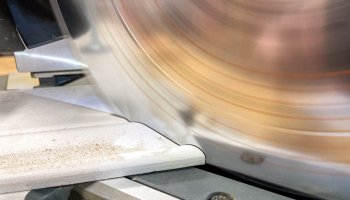
If you buy something through our links, ToolGuyd might earn an affiliate commission.
This is what I wish my workshop looked like – clean workbenches, clean floors, and nothing in the way.
Lean manufacturing principles are about reducing waste and improving efficiency.
Ben V has the right idea – shown above is what his workshop looked like after building a couple of modular workbenches and tool cabinets. (You can see what he’s been working on at @dusty.tools on Instagram.)
Every now and then I’ll hear some “lean manufacturing” tips and techniques, with some applying just as effectively to DIY workshops.
Lean manufacturing suggests that you should buy what you need as you need it.
I have a couple of sheets of baltic birch plywood in my garage, as well as hardwood boards. My material cache doesn’t stop there – I have a couple of small sheets of plastic, bar stock, and more. That’s more than I have immediate need for.
I still have a couple of 4-foot cypress 2x boards that I bought for building raised garden planter boxes.
Oh, I’m glad to have materials available for impromptu projects. The plywood will be used for an upcoming cabinet build, and I bought a few extra sheets to justify the delivery fee from the lumber yard.
I also tend to overbuy for ToolGuyd purposes. Part of the job is trying out new tools, accessories, brands, and so forth, and so it’s regular and habitual for me to buy more than I need.
But, I also have a tendency to overbuy, especially when I find something on sale. When I do this, some of the surplus sits around until I need it, which can sometimes take a while.
I often have multiple projects at various stages of planning and preparation. Sometimes a project might be delayed, changed, or put on hold for an extended period of time.
I hate having to make multiple trips to the store, and so I might buy extra. Do I need #10 x 1-1/2″ screws, or #8 x 1-1/4″? Sometimes things don’t work out as well in real life as they do on paper. So I tend to have Plan A and B purchase plans.
That mindset can be beneficial, and I am often glad I don’t have to waste money or time placing another order when my Plan A selections don’t work. An extra box of machine screws or other small fasteners will usually cost less than having to pay shipping twice.
Past experiences have also lead me to always ask myself “what if it doesn’t work?” or “what if I need more?” Overbuying can save me time and money.
I bought a couple of IKEA butcher block-type countertops a few years ago, and still have one left, plus a couple of still-usable offcuts. They work great for workbenches, tool stands, and heavy duty tops for cabinets.
IKEA doesn’t offer solid wood bitcher block countertops anymore, at least not that I have seen. They changed things up a few times over the years, but seemed to make the permanent change from solid wood wot wood veneer countertops.
I have another workbench project in the works, and the extra countertop should work perfectly there. Alternatives do exist, of course, they just cost more money; those IKEA birch (or was it beech?) countertops were a great deal, and delivery fee was the same whether I was buying one or six.
So on one hand, I’m glad to have the cache of materials I’ve accumulated. On the other hand, what about space?
Once I work through my plywood and wood boards, I’m going to try to adhere to a “buy as I need it” policy.
Maybe I can allow for some exceptions; I’m sure there could be a balance between how much I immediately need and how much will be good to keep on-hand.
A lot of my habits come from my buying supplies on sale to save money or overbuying to save money on multiple shipping fees. Sometimes I do similar when concerned about future availability or pricing.
I can only blame some of my lumber excess on recent years’ shortages. That led to a “buy it when I find it” mentality.
I don’t plan to have overstock. Often I roughly plan for how the extra materials will be used, at least in the context of lumber, but sometimes those plans change or are frequently interrupted by other priorities.
I’ve seen others’ workshops and know that I’m not alone in this. Woodworkers, for example, tend to hoard wood and offcuts.
I bought a piece of oak at the lumber yard last year when shopping for maple. It had a great grain pattern, and I knew I could use it for something, but I still haven’t committed it to a particular project yet. I couldn’t pass it up, and have no regrets.
Shifting mindsets isn’t easy.
“Do I need to buy this now? If I wait, can I easily buy it when I need it? Will it cost me substantially less to buy right now?”
There needs to be some margin for error or unexpected circumstances. If I need 40 fasteners, it’s a good idea to buy 50, in case some are defective.
If I need 18 board feed of wood for a project, buying 20 is a good idea (at least), just in case I need a little extra or have to cut around a knot. But do I need a 10 board feet project pack of cherry just because it’s on sale?
Having a full lumber rack, or stack in my case, isn’t a bad thing if you have the space. The same goes for other materials, components, or what-not.
But, I find myself being short on space while also being more capable of paying shipping fees twice if needed.
Being budget conscious occasionally leads me to think “what else should I order now instead of soon or later, to make the most of the shipping fee?” Or, if there’s a discount, I look ahead to what I might not want to spend full price on a few weeks (or months) later.
Sure, that might save me money, but leads to inefficient utilization or storage space.
Let’s say someone is starting to lift weights. Buying a set of dumbbells can cost substantially less than buying them one size at a time. The same goes for wrenches. There’s a point where it’s more cost effective to buy a set than just a couple of sizes.
The “lean manufacturing” way would be to buy just what I need as I need it, plus a little extra where it makes sense.
But lean manufacturing is about reducing or eliminating waste.
If I try to apply lean manufacturing practices, things start to look contradictory. I’m not a manufacturer with well-defined material or part needs. Do I waste a bit of space, or money? They are interdependent – saving space results in higher costs, and saving money results in less storage efficiencies.
Lean is about improvement, and about assessing the state of things to look for opportunities for improvement.
So, it’s not about finding lean manufacturing practices that work for me, but applying the “look for opportunities to reduce waste and improve upon something” philosophy to my specific needs and contexts.
What I think makes sense for me is to keep materials on-hand except when doing so interferes with other needs or activities.
I have a couple of rubber sheets that I use for gaskets, washers, and similar things, and that’s okay. But I think my goal for lumber and plywood should be to only keep on-hand what I might use in an immediate project.
It’s not easy – what if I have trouble finding clean 2x cedar again? Baltic birch can be hard to find in certain sizes now, and so I don’t entirely regret buying extra.
Lean manufacturing doesn’t demand I adhere to certain practices. The goal is to eliminate waste and seek improvement.
All of this came up recently because I ordered a couple of bars of aluminum, plus a heavily discounted 12″ x 36″ sheet that I don’t have concrete plans for yet, and wondered if I was being wasteful. Maybe it’s a little wasteful, but the savings are substantial (I plan to cut it up as needed), and as I can fit it on a shelf or in a corner, it’s relatively easy to store.
A 60″ x 60″ sheet of plywood isn’t as easy to store.
So, my hybrid approach will be to keep a small supply of easily-stored materials on-hand – the same as I’ve been doing for the past 15-18 years or so – and buy plywood and hardwood as-needed, aside for “gotta have that” hardwood boards and a 2x or two as they frequently come in handy.
Are there areas of improvement in your workshop? Work van or truck? Hobby corner?
I think that “lean” finally clicked for me. It’s not about certain practices, but the philosophy of assessing, improving, and repeating until everything is as efficient as can be.






